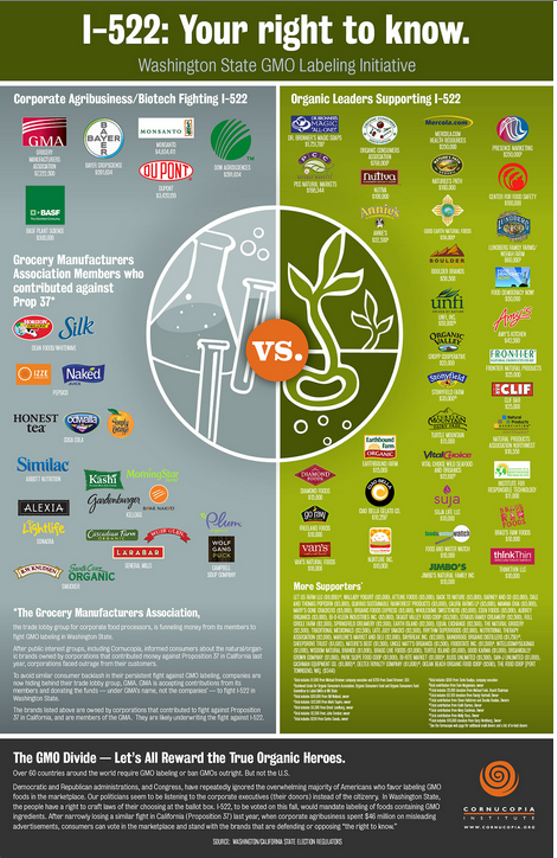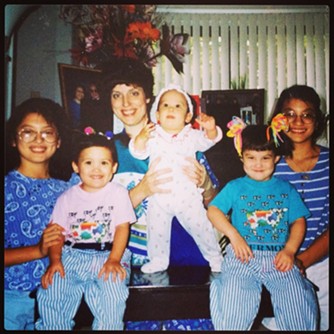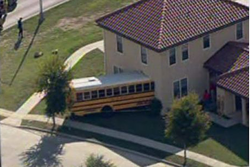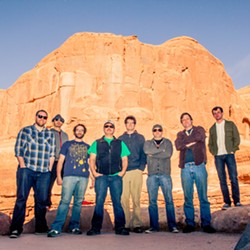Tuesday, October 29, 2013
In the ongoing and record-breaking battle over I-522, which would making Washington the first state to require labeling of food made with GMO ingredients, one of the main talking points is the cost. Ads from the pro-labeling side say it “won’t cost you a dime” while the anti-labeling side says it will cost a family of four $450 a year. So who’s right?
First of all, no one really knows.
As we’ve seen with other system changes — marijuana regulation, liquor privatization, health care reform — no one can accurately say how much it’s going to cost until it happens. The labeling required by I-522 would cost something. But estimates about how much and who would pay it are wildly different. Here’s what we know so far:
THE STATE
The state’s Office of Finacial Management offers one of the most specific estimates: $3.37 million in administrative costs over 6 years, which amounts to about 8 cents per state resident per year. But this estimate is only about costs for the state — rule development, enforcement, lab testing, etc. — and not about food production costs that could be passed on to consumers.
THE OPTIMISTS
California had a very similar measure on the ballot last year, and the pro-labeling camp has primarily promoted a study assessing that measure. Joanna M. Shepherd-Bailey of Emory University School of Law concluded that the California measure would result in trivial relabeling expenses that companies would not pass on to consumers:
Consumers will likely see no increases in prices as a result of the relabeling required by the Right to Know Act. A substantial body of empirical literature has established that important barriers to price adjustments exist that will deter suppliers from increasing prices to pass on the labeling expenses imposed by the Right to Know Act.
The pro-labeling (and vaccine-fighting) Alliance for Natural Health, which commissioned the first study, recently released a Washington state follow-up study by the same professor. It draws the same broad conclusions and says the “improbable, worst-case scenario” would be a one-year cost of $2.20 per person. The study does not address possible increases in food production costs.
In a separate independent study commissioned by the obviously pro-labeling group Just Label It and published in September, marketing expert Kai Robertson concluded there’s no evidence that changes to labels have an effect on supermarket prices.
There are no studies that document the impact of a product’s label change on prices charged by supermarkets. This is not too surprising given the interdependence of factors that influence prices set by supermarkets, inherent “stickiness” of prices set at the wholesale level and the regularity with which many labels are changed as part of a company’s normal business practices. In sum, this study finds no evidence that changes to a food processor’s product labels affect the prices paid by shoppers.
THE PESSIMISTS
On the other side of things, the anti-labeling side has relied on a study they commissioned by the business-friendly Washington Research Council, published in September. It estimates a initial-compliance cost of $264 million for farmers and food manufacturers.
On an ongoing basis, food manufacturers would either have to create special labels for the portion of their products sold in Washington state, or remake those products with higher-priced non-GE or organic ingredients to avoid the mandate to apply special labels. Those costs would be passed on to Washington consumers through higher food prices.
They estimate it would cost a family of four an extra $200-520 from 2015 to 2019, then $450-520 a year after 2019 when the zero-tolerance threshold part of I-522 goes into effect.
A similar study the campaign commissioned from Northbridge Environmental Management Consultants came to similar conclusions that grocery prices would rise $360 a year for a family of four through 2019, then $490 in subsequent years.
THE ACADEMICS
In response to a request from the state Legislature, the Washington Academy of Sciences released a report several weeks ago to answer five central questions about I-522. Unsurprisingly, one of those was about cost, and the researchers concluded that higher costs are likely.
Mandatory labeling, especially at a state versus federal level, is likely to affect trade and impose higher costs on firms producing and selling products in Washington. These costs are likely to be passed on to the consumer resulting in higher food prices.
The study doesn’t, however, put any actual dollar figures on its estimates. It points out that most of the cost to producers and food companies isn’t from relabeling, but from the need to segregate GMO and non-GMO products throughout the supply chain. (If you’re really interested in all of this, the references pages of that report serve as a good extended reading list.)
THE VARIABLES
In the end, the reason the estimates vary so much is that it depends on how consumers and food companies react — and we really don’t know what’s going to happen. (This Associated Press story and this excellent NPR piece both do a good job explaining the uncertainty.)
The two main scenarios:
1. If consumers avoid products with GMO labels (or food companies fear they will), costs would probably rise.
In Europe, many companies fearful of consumer rejection stopped using GMO ingredients altogether once labeling laws went into effect in the late ’90s. A lot of labeling supporters would be happy to see this happen — but it would almost certainly cause some increase in food prices as companies reformulate their products or fight for more expensive non-GMO ingredients. This is the assumption of the anti-labeling studies that predict families’ grocery bills would increase by hundreds of dollars.
2. If consumers don’t care, costs probably won’t change much.
The cost of the actual label change would be very small for most major companies. So if people are undeterred and keep on shopping as usual, it’s fair to expect very little effect on prices. But, if this is the case, companies would likely avoid the more substantial costs of keeping GMO and non-GMO separate by just slapping the GMO label on everything — an outcome that would leave us about as uninformed as we are now.
This is the assumption of the pro-labeling studies that conclude the label changes themselves wouldn't cost much. But most people who support labeling feel that it’s part of reforming the food industry and creating greater transparency, and that won’t happen without change. It’s unlikely the goal of reform will be achieved without some cost to consumers — and the question of how much just can’t be answered until it happens.
HERE
The wife of troubled developer Greg Jeffreys would rather you didn’t know part of the allegedly stolen money came from federal stimulus funds. (S-R)
A former Othello teacher was sentenced to a year in jail and sex offender treatment for molesting a 10-year-old student. (KXLY)
A former WSU political science professor was sentenced to up to five years for sexually assaulting a teen. (AP)
The No on 522 campaign has raised more money than any other initiative campaign in Washington state history. (Inlander)
THERE
It’s been a year since Hurricane Sandy caused massive destruction on the East Coast; some places have recovered and some really haven’t. (Atlantic In Focus)
And now a huge Atlantic storm is battering northern Europe, with at least 12 people dead. (BBC)
A federal judge struck down parts of the restrictive new abortion law in Texas. The state attorney general has already appealed. (Houston Chronicle)
A Colorado man getting a divorce says he converted $500,000 in life savings into gold and then threw it away to prevent his ex-wife from getting a penny. (Gazette, via Gawker)
Awww. Just try not to look at these adorable lion cubs in Oregon. (Oregonian)
Tags: Morning Briefing , News
Monday, October 28, 2013
UPDATE: On Monday, Monsanto chipped in another $540,000 to fight I-522, bringing the No campaign's total funding to nearly $22 million.
Per the Seattle Times:
First, it smashed the record for fundraising by a campaign opposing a statewide ballot measure.
Now, No on 522 holds the title for most money raised by any initiative campaign in Washington state history, period.
Bankrolled by out-of-state biochemical corporations and food industry heavyweights, the campaign trying to defeat GMO labeling Initiative 522 on Saturday broke the $21 million mark in total contributions, the latest campaign reports to Washington’s Public Disclosure Commission (PDC) show.
In the process, the No camp surpassed Washington’s previous high mark of money raised by any initiative campaign. The old record — set in 2011 by Costco-backed supporters of the liquor-privatizing Initiative 1183 — was $20.1 million.
The No on 522 campaign reached record ground fueled by last week’s contributions of $3.8 million from the food-industry PAC the Grocery Manufacturers Association, and $460,000 from biochemical giant Dupont Pioneer.
The Yes on 522 campaign, meanwhile, has raised about a quarter of its opponent's war chest — $6.3 million. Dr. Bronner's Magic Soaps is still the campaign's biggest contributor, having poured $1.7 million into the effort. The Yes camp's latest big-ticket donations pale in comparison to the No side's recent influx of cash. Last week, Aveda founder Horst Rechelbacher, now CEO of organic beauty company Intelligent Nutrients, gave $50,000 to the campaign; health food producer Nutiva donated $35,000; and American Halal Company, maker of Saffron Road frozen foods, contributed $22,500.
The No campaign's expensive campaign strategy seems to be paying off. According to the latest Elway poll, support for I-522 is waning: 46 percent of voters surveyed said they support the measure while 42 percent said they oppose it. The difference is now within the margin of error.
Want to know where your favorite food brand stands on GMO labeling?
The Cornucopia Institute has created this infographic showing which popular organic/natural food manufacturers have financially backed or opposed labeling in Washington.This week the Inlander celebrates 20 years of existence, and our publisher put together an album of photos from the Inlander’s early days of planning around kitchen tables and sharing computers.
When the first issue went out in October 1993, a lot of us who are now writers and editors weren’t doing a lot of sophisticated reading yet. (Some of our interns weren’t even born.) Here’s what we were up to when the Inlander got started:
Chris Bovey, art director
I was 13. Yeah, I used to get beat up a lot.
Chey Scott, listings editor
At almost the very same time the Inlander was born back in 1993, I was about to become a big sister for the second time, to my little brother Andrew (born Nov. 6). I was in kindergarten at Lake Spokane Elementary, in Nine Mile Falls.
I remember during class one day my teacher, Mrs. Byers, was announcing who had been named “Mustang of the Month” for being an outstanding student. (Yes, it’s true, I was a teacher’s pet from the start.) In a speech before revealing which of us got the award, she gave away a few hints, including: “this student has just become a big sister.” Yet, this didn’t strike me as specific to me since I already had been one, to my little sister, Erica. Weeks later, I remember my mom bringing baby brother Andrew to be my “show-and-tell.”
The rest of those first months of kindergarten were a blur of singing songs and making dried-bean-and-glue collages. I was also pretty stylish back then — though I wasn’t recognized by my classmates for it — my Gramma made just about my entire school wardrobe.
Heidi Groover, staff writer
This is probably about what I was doing then.
Laura Johnson, music editor
The start of 1993 was forever burned into my then-6-year-old brain when the lights flickered out. A wind storm of enormous magnitude, now known as the Inauguration Day storm since it fell on the same day President Clinton was sworn in, crashed down on the Seattle area taking out many trees and our power lines along with them. For days my family of four was without power. We huddled in piles of blankets the living room as my dad fed log after log to the fireplace, our only source of heat, while listening to the radio newscasters rattle off updates about the blackout. My parents cooked dinner on the grill in the backyard. I was told not to open the refrigerator or else we'd lose all the food sealed within. At night we lit candles to be able to see each other. At first it was like camping; new and exciting (plus, I didn't have to go to school). But then, it got to the point where being cold and not being able to watch TV just wasn't fun anymore. Once the power went back on, I swore I'd never take a light switch for granted again. But soon, going on with my daily first grade life, I forgot all about how it was to be without power.
Deanna Pan, staff writer
I’m rocking the pigtails on the right.
Jacob Jones, staff writer
A lot of things happened in 1993. Bill Clinton was sworn in as president. Czechoslovakia dissolved into Slovakia and the Czech Republic. Some alt-weekly paper started in Spokane.
But my entire childhood also transformed that year with the release of the movie Jurassic Park.
Steven Spielberg's cinematic marvel completely blew my 8-year-old mind. I made my parents sit through it at least two or three times in the theater. I could not get enough of those terrifyingly real dinosaurs.
From then on, my friends and I would spend countless hours imitating and imagining prehistoric beasts in all their computer-generated glory. It's really the only thing I cared about that whole year.
Lisa Waananen, web editor
I was a second-grader in the fall of 1993, and my mom convinced me to grow out my bangs. I wasn’t a fan. The bangs were back by third grade.
Not enough girls signed up for fall soccer, so I was the only girl on my team. Since I grew up in Minnesota, land of the Vikings, the purple-and-yellow shirts were the best colors your team could get. I didn’t mind being the only girl and I took pride in never crying if I got hit in the face with the soccer ball. I did cry whenever we lost a game, and I got a lot of after-game lectures about being a good sport and not yelling at my teammates.
Tags: 20th Anniversary , For Fun! , Image
The City of Spokane held its Fall Leaf Festival at Finch Arboretum on Saturday. Children played in a large pile of leaves while their parents took photos and sometimes participated in the fun. Those who attended learned how to compost from the Spokane Master Composters, learned about conservation at various informational booths, and enjoyed the fall foliage around the park.
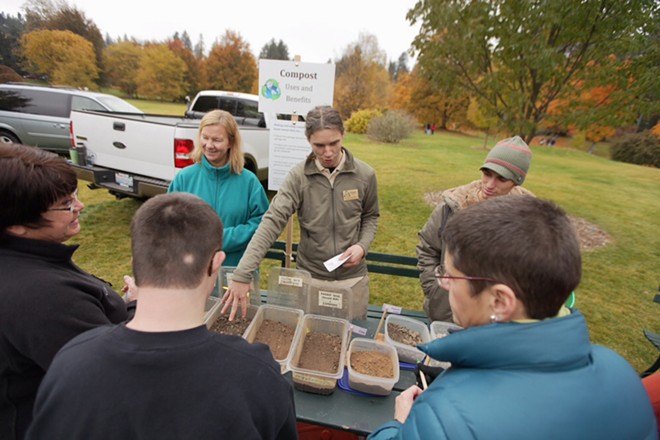

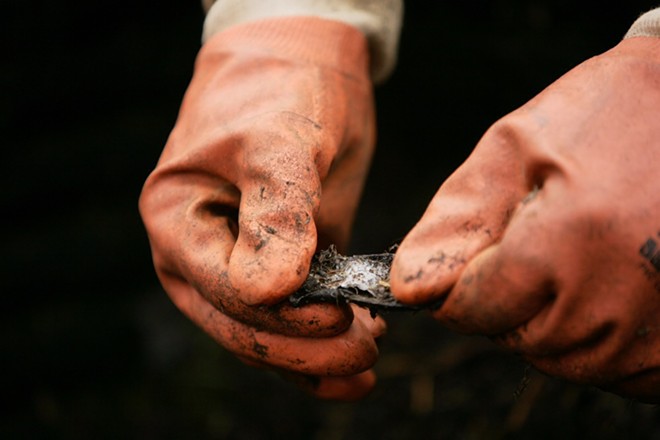





Tags: Finch Arboretum , Fall Leaf Festival , City of Spokane , Spokane Master Composters , composting , fall , autumn , News , Image
HERE
It’s cold! It’s windy! A few thousand people have been without power since last night. (S-R)
Gonzaga students attacked late at night by a man and woman wearing red hoodies with their faces painted like skeletons. (KHQ)
Coeur d’Alene Summer Theatre may live on after all, though in a smaller form. (Cda Press)
Spokane nonprofit Transitions, which helps homeless women and children, is getting a brand new community room after winning a national interior design contest. (KXLY)
NEAR
Tribal leaders have been asking the University of Washington to build a longhouse on campus for decades, and they finally broke ground on Friday. (Seattle Times)
An apartment fire in Wenatchee is being blamed on a dog that accidentally turned on the stove while reaching for treats. (AP)
Thomas Robinson of the Portland Trail Blazers got a speeding ticket for driving 107 mph on I-5. (Oregonian)
THERE
Lou Reed, the Velvet Underground leader and rock pioneer, died at 71. (Rolling Stone)
More than 60 people were killed in a series of blasts around Baghdad on Sunday, mostly targeted in Shiite areas. More than 600 people have been killed this month. (Al Jazeera English)
Five people are dead after a car crashed in Tiananmen Square and caught fire. (BBC)
Documents from the Edward Snowden leak seem to indicate the U.S. has been spying on the German chancellor, Angela Merkel, dating back to 2002. And since she’s supposed to be our friend, it’s kinda awkward. (NYT)
TOO CLOSE
A school bus crashed into a home in Texas on Friday after the brakes went out — and that’s my cousin’s house! His family just moved in several weeks ago. His wife and two younger children were inside at the time, and the older two were among the elementary school students on the bus. They were all fine; five other people had minor injuries. (Houston Chronicle)
Tags: Morning Briefing , News , Image
Friday, October 25, 2013
This weekend, the Spokane Humane Society is celebrating the opening of a new adoption center inside the North Spokane PetSmart store (9950 N. Newport Hwy.) where the shelter is now able to house up to 38 adoptable dogs and cats.

The new adoption center benefits both the Spokane Humane Society and the Inland Northwest's homeless pet population in many ways, most importantly by freeing up space at SHS's facilities (6607 N. Havana St.), allowing the organization to accept more animals into its care. Since animals started moving into the roomy kennels at the adoption center in mid-September, more than 80 pets have already been adopted. The new PetSmart adoption center is now one of 18 facilities like it in the U.S. Before it opened, the store had a much smaller room that featured only adoptable cats, from both the Spokane Humane Society and SpokAnimal. SpokAnimal continues to use the previously existing cat room for its adoptable kitties, while the new facility features adoptable animals as part of an exclusive agreement with SHS. The goal is to adopt out more than 1,000 pets at that center each year, adding to the Spokane Humane Society's average animal placement of between 2,500-3,500 pets each year.

Another major benefit of the new adoption area is its visibility to PetSmart customers who pass by its wide windows as they shop. Most adoptions that have taken place so far have been by shoppers who were there to buy items for pets they already own.
A press release about the center's grand opening from PetSmart Charities — a nonprofit organization separate from the retail corporation, and which funds centers like the new adoption center — featured a similar story about two cats, Missy and Sandoz, recently adopted by a customer who saw them while picking up food for her other cats at home.
Not only does the facility provide more chances for animals there to be noticed, it includes open areas for prospective adopters to play and interact with the dogs and cats there. Some of the cats housed there are able to stay in free-roaming cat rooms in place of a kennel, but the size of the kennels can also be reconfigured depending on the number of cats at the center.
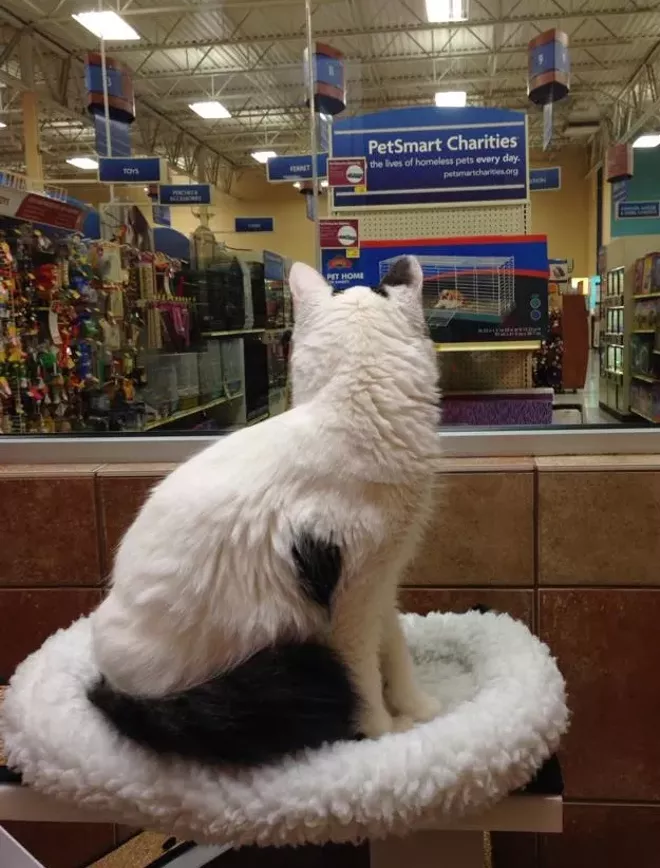
Funding for the new center's construction was provided by PetSmart Charities, with space inside the store donated by PetSmart. Most of PetSmart Charities funding comes from individual donations, including an option when customers check out to add a donation to their total.
The new adoption center is open seven days a week, during PetSmart's regular shopping hours, Mon-Sat from 9 am-9 pm and Sun from 10 am-6 pm.
Tags: Cat Friday , Spokane Humane Society , PetSmart , SCRAPS , SpokAnimal , Culture , For Fun! , News , Arts & Culture , Image
Winston Churchill's recipe for success — "Economy of effort. Never stand up when you can sit down, and never sit down when you can lie down." — may actually be bad for your health. Check out this animated guide on the basics of good posture.
What do you do to keep moving at the office?
Tags: workplace , Culture , For Fun! , Arts & Culture , Video , Image
I have no idea what is wrong with this
Local graphic designer/artist/musician Nick Tibbetts found this
As one YouTube commenter points out, he kinda sounds like a death metal singer.
FRIDAY
Losing Skin is pretty busy this weekend. First they host a Halloween Misfits Cover show at The Hop! Friday. That lineup features Reason for Existence, Faus, Lay the Tarp and more. The night starts at 6 pm and is $7 or $5 with costume. Saturday, the local metal group moves their show to Mootsy’s. That night will include Dislich, Bloody Gloves and Brothers Ov Midnite. The venue is taking a $5 cover or $3 with costume, it starts at 8 pm.
The Federico Aubele concert that was supposed to serve as The Bartlett’s soft opening show has been moved next door to the 21-and-over nYne. The evening will include Lisa Alma, Bias and The Diving Jewels. The show is $10 at the door and begins at 7 pm.
SATURDAY
Seattle may not be Memphis, but people can get funky there too. Bringing that rhythm to Moscow this weekend is the eight-piece group, the Polyrhythmics. A conglomeration of afro beats, multiple horned instruments and brand of swanky, coolness, their music pulls your ears in — even without the enticement of vocals.
Formed three years ago, the band has gone on to tour up and down the West Coast and releases two full-length LPs. A self-described brotherhood, their song titles such as “Stinky Finger” and “Nurple” prove the act likes to have a lot of fun all while still taking their music seriously. Pop in one of their albums while driving around and you’re sure to feel a bit like you’re in a James Bond film. The show starts at 9:30 pm at John’s Alley in Moscow. Cost is $5.
More shows of interest:
- Cursive Wires and Hannah Reader take on Jones Radiator
- The Viking Bar will put on a “Show Me Your Tatto” Halloween show featuring Jimmy Nuge, Nixon Rodeo, Eyes Like Time Machines and The Lion Oh My
SUNDAY
If Brian Wilson and Kurt Cobain were to collaborate, the result might be the San Francisco three-piece, Couches. With heavy guitars, easy rock rhythms, A California beach vibe and “don’t tell us what to do” kind of lyrics, Couches is a breath of fresh air from all the electronic or folk-inspired music new bands keep putting out these days. This can all be heard on the recently released 7-inch, which contains the song, California, an awesome antithesis to The O.C. theme song. Playing Treefort Music Fest in Boise earlier this year, the band is back in the Pacific Northwest to tear it up (and potentially eat some burritos) at the Baby Bar this Sunday at 8 pm, that’s right folks, fo’ free. Openers include Chung Antique and Normal Babies.
Tags: This weekend in music , Couches , Halloween , Music , Image , Video


